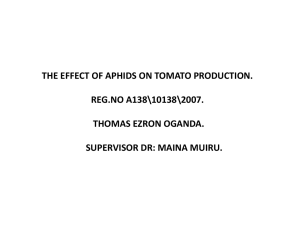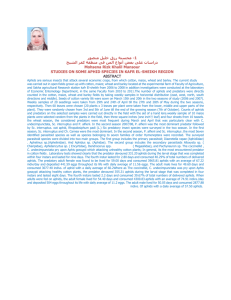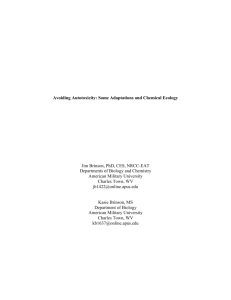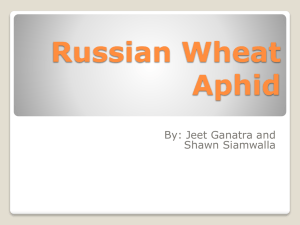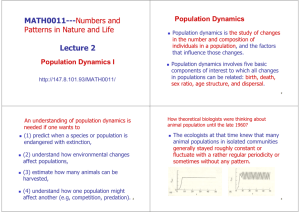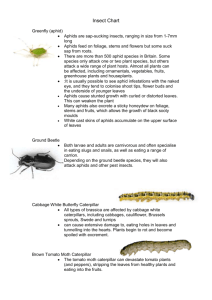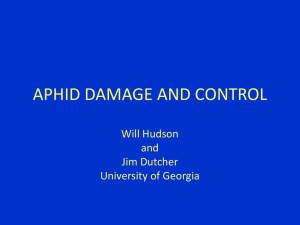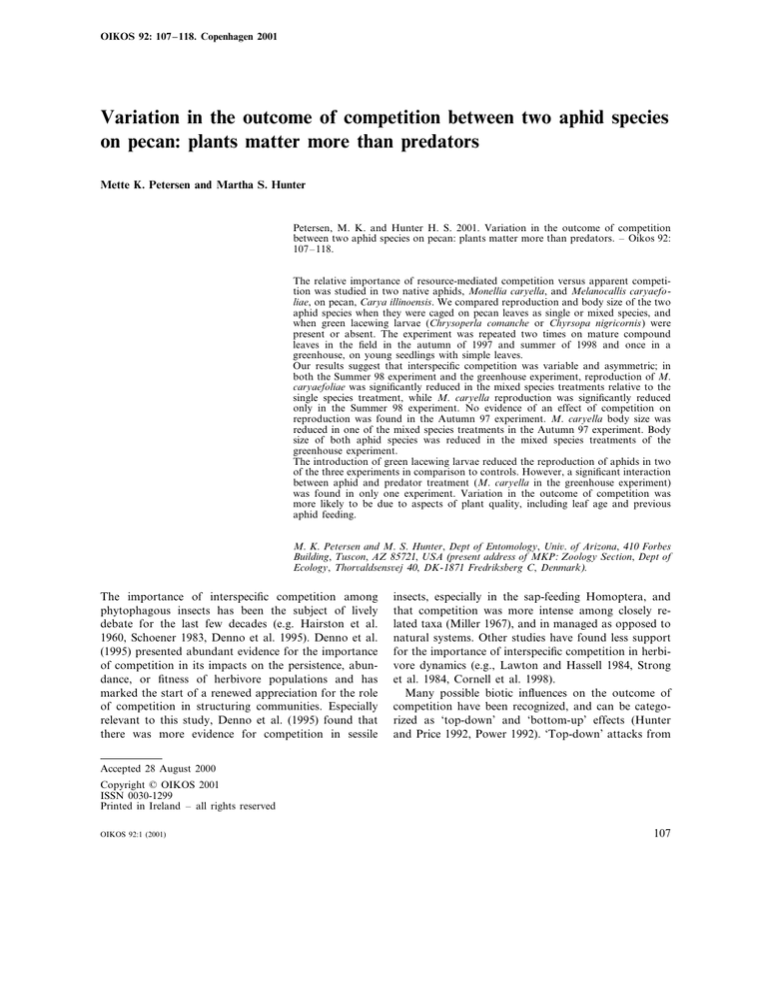
OIKOS 92: 107–118. Copenhagen 2001
Variation in the outcome of competition between two aphid species
on pecan: plants matter more than predators
Mette K. Petersen and Martha S. Hunter
Petersen, M. K. and Hunter H. S. 2001. Variation in the outcome of competition
between two aphid species on pecan: plants matter more than predators. – Oikos 92:
107–118.
The relative importance of resource-mediated competition versus apparent competition was studied in two native aphids, Monellia caryella, and Melanocallis caryaefoliae, on pecan, Carya illinoensis. We compared reproduction and body size of the two
aphid species when they were caged on pecan leaves as single or mixed species, and
when green lacewing larvae (Chrysoperla comanche or Chyrsopa nigricornis) were
present or absent. The experiment was repeated two times on mature compound
leaves in the field in the autumn of 1997 and summer of 1998 and once in a
greenhouse, on young seedlings with simple leaves.
Our results suggest that interspecific competition was variable and asymmetric; in
both the Summer 98 experiment and the greenhouse experiment, reproduction of M.
caryaefoliae was significantly reduced in the mixed species treatments relative to the
single species treatment, while M. caryella reproduction was significantly reduced
only in the Summer 98 experiment. No evidence of an effect of competition on
reproduction was found in the Autumn 97 experiment. M. caryella body size was
reduced in one of the mixed species treatments in the Autumn 97 experiment. Body
size of both aphid species was reduced in the mixed species treatments of the
greenhouse experiment.
The introduction of green lacewing larvae reduced the reproduction of aphids in two
of the three experiments in comparison to controls. However, a significant interaction
between aphid and predator treatment (M. caryella in the greenhouse experiment)
was found in only one experiment. Variation in the outcome of competition was
more likely to be due to aspects of plant quality, including leaf age and previous
aphid feeding.
M. K. Petersen and M. S. Hunter, Dept of Entomology, Uni6. of Arizona, 410 Forbes
Building, Tuscon, AZ 85721, USA (present address of MKP: Zoology Section, Dept of
Ecology, Thor6aldsens6ej 40, DK-1871 Fredriksberg C, Denmark).
The importance of interspecific competition among
phytophagous insects has been the subject of lively
debate for the last few decades (e.g. Hairston et al.
1960, Schoener 1983, Denno et al. 1995). Denno et al.
(1995) presented abundant evidence for the importance
of competition in its impacts on the persistence, abundance, or fitness of herbivore populations and has
marked the start of a renewed appreciation for the role
of competition in structuring communities. Especially
relevant to this study, Denno et al. (1995) found that
there was more evidence for competition in sessile
insects, especially in the sap-feeding Homoptera, and
that competition was more intense among closely related taxa (Miller 1967), and in managed as opposed to
natural systems. Other studies have found less support
for the importance of interspecific competition in herbivore dynamics (e.g., Lawton and Hassell 1984, Strong
et al. 1984, Cornell et al. 1998).
Many possible biotic influences on the outcome of
competition have been recognized, and can be categorized as ‘top-down’ and ‘bottom-up’ effects (Hunter
and Price 1992, Power 1992). ‘Top-down’ attacks from
Accepted 28 August 2000
Copyright © OIKOS 2001
ISSN 0030-1299
Printed in Ireland – all rights reserved
OIKOS 92:1 (2001)
107
natural enemies may change the relative abundance of
co-occurring herbivores. This has been called ‘apparent competition’ (Holt 1977), in which independent
interactions of herbivores with their shared natural
enemies may lead to patterns similar to those expected by direct resource-based competition. Apparent
competition may operate by several different mechanisms. An example is if the natural enemies exhibit
preference for one of the herbivore species (Settle and
Wilson 1990, Karban et al. 1994) or if no preference
is exhibited but density thresholds for predator aggregation are more likely to be exceeded in two-species
patches leading to suppression of the slower growing
species (Müller and Godfray 1997). Over a longer period, the prey species with a greater reproductive rate
will better be able to withstand non-selective predation and will prevail over the slower-growing species
(Holt and Lawton 1993, Bonsall and Hassell 1997).
Over a shorter period, the reverse situation can also
occur; predator satiation in two-species patches may
lead to a short-term ‘apparent mutualism’ of the
predator with the slower-growing population (Edson
1985, Bergeson and Messina 1997).
An emerging area of study is the potential influence
of the ‘bottom-up’, host-plant quality effects on competitive outcome (Karban and Myers 1989, Hunter
and Price 1992, Power 1992, Masters et al. 1993, Inbar et al. 1995, Karban and Baldwin 1997, Inbar et
al. 1999, Fisher et al. 2000). Clearly, these effects are
likely to be complex, with variation in plant nutrition,
constitutive plant defense, and local and systemic induced responses all having the potential to differentially affect one of a pair of herbivores sharing the
same plant resource. These types of indirect interactions are likely to be relatively common, and are interesting because like other ‘interaction modifications’
(Wootton 1994), changes in the intermediary species
(here the host plant) alters not only the relative abundance of the competing species, but also the quality
of the interaction between the herbivores. The extent
to which plant quality explains spatial and temporal
variation in the intensity of herbivore competition is
still not well known (Denno et al. 1995).
Identification of the relative potential importance of
‘top-down’ and ‘bottom-up’ forces in mediating interspecific competition within particular communities is
likely to provide a clearer understanding of community dynamics (Denno et al. 1995). In this study, we
examined interactions between two closely related
aphid species on pecan in the field at two times in
the tree phenology as well as on pecan seedlings in
the greenhouse. We asked whether competition could
occur, whether competition could be mediated by
lacewing predators, and whether the outcome of the
interaction was influenced by variation in foliage age
and quality.
108
Study system
Pecans (Carya illinoensis (Wang.) K. Koch) are native
to the southeastern and south central United States and
were recently introduced to the western US as a horticultural crop. Only two of its native herbivorous insects
are abundant and reach pest status in Arizona orchards: the blackmargined pecan aphid, Monellia
caryella (Fitch), and the black pecan aphid, Melanocallis caryaefoliae (Davis) (both Sternorrhyncha: Aphididae: Drepanosiphinae: Phyllaphidini). Both aphid
species feed on the compound leaves, and co-occur
throughout most of the year, although their populations often peak at different times (Tedders 1978, Petersen unpubl.). Early in the season there appears to be
some resource partitioning between the two aphid species; M. caryella is more abundant in the outer parts of
the canopy and M. caryaefoliae is more abundant in the
central parts (e.g., Tedders 1978). The aphids also differ
slightly in where they feed on the leaf. While both
species appear to prefer to feed on the underside of the
leaf, M. caryaefoliae is also found on the upper surface
(Tedders 1978). Further, M. caryella tends to feed on
primary leaf veins, while M. caryaefoliae prefers tertiary
and quaternary veins (Tedders 1978, Kaakeh and
Dutcher 1994).
Both M. caryella and M. caryaefoliae overwinter as
eggs under the bark or in crevices on pecan trees. In the
spring, fundatrices hatch from the eggs and initiate
several generations of parthenogenetic females during
the spring and summer. All adults have wings. In the
autumn, sexual individuals develop and co-occur with
parthenogenetic females. Oviparous females mate and
then lay the overwintering eggs (Bissell 1978, Tedders
1978). The aphids can survive on the pecan leaves until
leaf fall at the time of the first frost (November or
December in southern Arizona).
In commercial pecan orchards, pecan aphids are
considered serious pests. Feeding by M. caryaefoliae
may cause defoliation if the population outbreak is
severe. The honeydew produced by M. caryella is ten
times higher in glucose-equivalents than that produced
by M. caryaefoliae (Wood et al. 1987) and reduces
photosynthesis and serves as substrate for sooty mold,
a secondary fungus (Tedders 1978, Wood et al. 1985,
1987). Other studies have suggested that the two aphid
species may be differentially affected by natural enemies
because M. caryella produces copious amounts of honeydew. It has been suggested that the honeydew of M.
caryella may attract or arrest natural enemies to a
greater extent than the honeydew of M. caryaefoliae
(Bumroongsook and Harris 1992, Harris and Li 1996).
Green lacewings are among the most abundant natural
enemies in pecans (Liao et al. 1985). In southern Arizona the species Chrysoperla comanche (Banks) and
Chrysopa nigricornis Burmeister were most abundant
(Petersen unpubl.).
OIKOS 92:1 (2001)
Differences in morphology and behavior of the
aphids may also influence their interactions with natural enemies. M. caryaefoliae is olive-green to black,
appears to be more sclerotized and bears a number of
tubercles on the thorax and abdomen, while M. caryella
is pale yellow and relatively smooth-bodied (Tedders
1978). Both aphids are disturbed easily (Tedders and
Thompson 1981) but our casual observations suggest
their response to disturbance is different; M. caryaefoliae is more likely to jump and M. caryella to walk or
fly.
The two pecan aphid species also have different
interactions with the host plant. Feeding by M. caryaefoliae causes chlorotic and necrotic damage to the leaf
tissue as well as an increase in free amino acids in the
phloem. In contrast, M. caryella often leaves no macroscopic evidence of damage and the levels of free amino
acids in the phloem of fed-upon leaves is similar to
control leaves (Petersen and Sandström unpubl.). The
large amount of honeydew produced by M. caryella is
likely to be a consequence of this aphid’s inability to
increase the phloem amino acid content. Feeding by M.
caryella causes microscopic damage to sieve elements
(Tedders and Thompson 1981, Wood et al. 1985),
which appears to reduce the ability of later-feeding M.
caryaefoliae to manipulate the phloem amino acid content, thus reducing its reproductive performance (Petersen and Sandström unpubl.).
Methods and materials
Insect cultures
Pecan aphids and green lacewings were collected in the
orchard block that was the location of the field study
(see below). The two pecan aphid species were reared in
the greenhouse on pecan seedlings germinated from
nuts of ‘Wichita’ variety trees intercropped with ‘Western Schley’ variety pollinator trees. The green lacewing
species C. comanche and C. nigricornis were reared on a
mixture of bird cherry oat aphids (Rhopalosiphum padi
L.) and greenbugs (Schizaphis graminum Rondani).
These aphids were reared on barley seedlings. All cultures were kept in cages at 20–27°C and lighting was
provided to extend the day length to 15 h.
Field experiments
Field experiments were carried out during October 1997
and June 1998 (here called ‘Autumn 97’ and ‘Summer
98’). Experiments were performed in the central part of
an unsprayed pecan orchard block (10 ha) on trees that
were approximately 30 yr old in Sahuarita, Arizona
(31° 57% N, 111° 00% W). The experimental unit consisted of a single compound leaf enclosed in a sleeve
OIKOS 92:1 (2001)
cage (56 cm long and 17 cm wide) made of nylon
organdy and supported by a circular wire frame near
the top of the cage. The top of the cage was closed
around the petiole with a wire twist tie tightened
around a block of foam rubber. The bottom of the cage
was closed similarly. Each leaf was washed on both
sides with a moistened sponge before being caged. One
week after the cages were placed over the leaves, pecan
aphids were introduced. Adult aphid females that were
less than 24 h old were aspirated into glass tubes and
kept cold in an ice chest during transport to the field.
Four different aphid treatments were performed; (1)
10 M. caryaefoliae, (2) 10 M. caryella, (3) a mixture of
5 M. caryaefoliae+ 5 M. caryella or (4) a double density mixture of 10 M. caryaefoliae+ 10 M. caryella.
These four aphid treatments were randomly set up on
the four fully developed terminal leaves on each branch
used. In the ‘Autumn 97’ experiment, two branches
were used on both the north and the south facing
section of three trees for a total of 12 replications per
treatment. In the Summer 98 experiment three different
branches on both the east and the west facing sections
of six trees were used for a total of 36 replications per
treatment.
In the Autumn 97 experiment, a predator treatment
was randomly assigned to each of the aphid treatments
19 d after the infestation with aphids. The predator
treatment was either (1) no predator (‘control’) or (2)
two newly hatched first instar C. comanche larvae. Each
treatment combination (aphid ×predator) was replicated six times. The experiment was terminated five
days after introduction of the lacewing larvae; caged
leaves were cut off and brought back to the laboratory
where the number of C. comanche larvae and aphids
(adults and nymphs of each species) were counted. In
this experiment as well as in the other two, aphids in
the mixed species treatments were intermixed on the
leaves at the time of counting; there was no evidence of
spatial partitioning of the leaf surface with respect to
aphid species. Dry weight was measured after freeze
killing of adult aphids from predator ‘control’ treatments and of lacewing larvae that were alive at the end
of the experiment. Aphids were dried for 24 h and
lacewing larvae for 48 h, both at 60°C. Weights were
measured on a CAHN C31 Electro balance.
In the Summer 98 experiment, the number of adults
and nymphs of each aphid species was counted 15 d
after introduction of aphids. A predator treatment was
then randomly assigned to each of the aphid treatments. The predator treatments were (1) no predator
(‘control’), (2) one second instar C. comanche larva or
(3) one second instar C. nigricornis larva. Each treatment combination (aphid × predator) was replicated 12
times. Two days after the introduction of the predators,
the number of adults and nymphs of each aphid species
were counted again. The lacewing larvae were killed
and the dry weight determined after 48 h at 60°C.
109
Hourly readings of the air temperature (2 m above
the soil surface) during both field experiments were
obtained from the Arizona Meteorological Network
(AZMET) Campbell farm station (Tucson, AZ) which
has the most similar climatic conditions to the field
site (P. Brown, AZMET, pers. comm.). Estimation of
the cumulative physiological time accrued in the three
experiments was made using an estimated temperature
threshold of T0 =5°C. This value was obtained from
another tree-living aphid species belonging to the
genus Myzocallis Passerini (Sternorrhyncha: Aphididae: Drepanosiphinae: Phyllaphidini) (P. Kindlmann
pers. comm.).
Greenhouse experiment
A greenhouse experiment was carried out during October 1998. The experimental unit was a pecan seedling
with 5–7 simple leaves. Each plant was grown in a pot
(17 cm high with a diameter of 15 cm – 3.8 l) with
Premier® Pro Mix soil. Plants were watered regularly
with tap water. The aphid treatments were the same as
used in the field experiments (see above) and were
blocked in time with a total of 18 replicates. After
introduction of adult aphids, each plant was covered
with a fabric bag made of nylon organdy (57 cm high
and 35 cm wide) secured with rubber bands around
the pot below the rim. After 17 d incubation in the
greenhouse at 15 h light per day the number of aphids
(adults and nymphs of each species) was counted.
Thereafter, a predator treatment was assigned to each
pot and the bag was replaced over the plant. The two
predator treatments were (1) no predator (‘control’) or
(2) one newly molted second instar C. nigricornis
larva. The treatments were blocked in time and each
treatment combination (aphid ×predator) was replicated 9 times in a complete randomized block design.
Five days after initiation of the predator treatment,
the experiment was terminated. The number of aphids
(adults and nymphs) was counted. The dry weight of
the lacewing larvae and dry weight of adult aphid
specimens from the ‘control’ predator treatment was
measured (see above). Temperature in the greenhouse
was measured every 30 min by a temperature logger
mounted on a (non-experimental) pecan seedling.
Statistical analysis
In all three experiments, an analysis of variance using
aphid species as a main factor was used to analyze the
number of aphids in the single and high density mixed
species treatments. An overall test of the results on
interspecific competition from the three experiments
was done by a simple meta-analysis combining probabilities from each of the experiments ( − 2S ln P, with
110
a x2 distribution with 2k degrees of freedom, where k
is the number of seperate tests) (Sokal and Rohlf
1995). A paired t-test was used to compare aphid
numbers in the two mixed species aphid treatments
(high and low density). The dry weights of aphids in
the single and mixed species treatments, and the proportional abundance of the aphid species in the two
species mixture treatments were both tested by analysis
of variance using aphid treatment as a main factor. In
the analysis of aphid weights, leaf area and the number of aphids were used as co-variates. The per capita
rate of increase for each aphid species was calculated
using the equation Nt = N0 lt, where N0 is the initial
density and Nt the number of aphids after t days. A
value of l\ 1 indicates a population increase and a
value lB 1 indicates a population decrease. A comparison of the per capita rate of increase was performed by analysis of variance with aphid treatment
and predator treatment as main factors. A significant
interaction of aphid and predator treatments would
provide evidence of apparent competition in our experiments. For all three experiments, leaf area was
used as a co-variate. A test of lacewing larval performance as measured by final dry weight was performed
using analysis of variance with aphid treatment as a
main factor and the number of aphids at the time of
predator introduction as a co-variate (the latter only
the Summer 98 and the greenhouse experiments).
Results
Population growth of aphids in single species
treatments
Population growth of the two pecan aphids in single
species treatments was not significantly different in
any of the three experiments (Fig. 1). Populations
reached a mean number of 104 or less when they were
developing on single compound leaves in the field;
both in the Autumn 97 and the Summer 98 experiment (Fig. 1A, B). The two species also reached similar mean numbers when in single species treatments on
pecan seedlings in the greenhouse, but while the leaf
area of pecan seedlings was generally about twice the
leaf area of a single compound leaf in the field, the
mean number of aphids was 7 – 12 times greater on
pecan seedlings in the greenhouse than on compound
leaves in the field. Differences in physiological time
accrued in the three experiments are unlikely to explain this difference in reproductive rate. In the Autumn 97 experiment, populations were censused after
312°D (24 d) while in the Summer 98 experiment the
aphid census occurred after 320°D (15 d). In the
greenhouse experiment, aphids were censused at 306°D
(17 d).
OIKOS 92:1 (2001)
The outcome of competition: mixed species
treatments
The outcome of competition was variable in the three
experiments. While in the Autumn 97 experiment, the
mean numbers of each aphid species were almost exactly equal in the two mixed treatments (Table 1), in
the Summer 98 experiment, M. caryella comprised a
mean proportion of 0.82 of the aphids present in the
low density species mixture and 0.75 in the high density
mixture (Table 2). Leaves in the two field experiments
differed not only in age, but also in histories of aphid
infestation. In 1997 the mean number of M. caryella
reached a peak of 129 per leaf in June, higher than the
Fig. 1. Mean number 9 SE of pecan aphids in the single species treatments. (Black bars) Melanocallis caryaefoliae and (dashed
bars) Monellia caryella. Initial density was 10 B24-h-old adults in each cage. (A) Field experiment on single compound leaves
in sleeve cages, Autumn 1997. N = 6 at day 24. F1,11 =0.06, P =0.81. (B) Field experiment on single compound leaves in sleeve
cages, Summer 1998. N =36 at day 15. F1,67 = 1.04, P= 0.31. (C) Greenhouse experiment on pecan seedlings. N= 18 at day 17.
F1,33 = 0.00, P = 0.97.
Table 1. Field experiment, Autumn 97. Mean number 9 SE of M. caryella and M. caryaefoliae and proportion of M.
caryaefoliae (mean9 SE) of the total number of aphids in treatments where both species were introduced with a density of either
5 or 10 of each species. The number of aphids of each species was compared within treatment by a paired t-test. The number
of aphids of one species was compared between the two aphid treatments by a t-test. N= 6.
M. caryella
M. caryaefoliae
Paired t-test
Proportion of M. caryaefoliae of the total
number of aphids
Low (5+5)
High (10+10)
Statistics
68 9 22
78 934
t =−0.20 NS
0.50 90.16
75 9 8
96 9 28
t=−0.87 NS
0.51 90.09
t = 0.75 NS
t = 0.68 NS
F1,9 =0.05 NS
Table 2. Field experiment, Summer 98. Mean number 9 SE of M. caryella and M. caryaefoliae and proportion of M.
caryaefoliae (mean 9SE) of the total number of aphids in treatments where both species were introduced with a density of either
5 or 10 of each species. The number of aphids of each species was compared within each aphid treatment by a paired t-test. The
number of aphids of one species was compared between the two aphid treatments by an F-test. N =36.
M. caryella
M. caryaefoliae
Paired t-test
Proportion of M. caryaefoliae of the total
number of aphids
OIKOS 92:1 (2001)
Low (5+5)
High (10+10)
Statistics
96 9 11
21 95
t =4.52, PB0.001
0.18 90.04
52 98
13 93
t =3.83, PB0.001
0.25 9 0.04
F1,65 =11.30, PB0.01
F1,65 =1.38 NS
F1,64 =1.33 NS
111
Table 3. Greenhouse experiment. Mean number 9 SE of M. caryella and M. caryaefoliae and proportion of M. caryaefoliae
(mean9SE) of the total number of aphids in treatments where both species were introduced with a density of either 5 or 10
of each species. The number of aphids of each species was compared within each aphid treatment by a paired t-test. The number
of aphids of one species was compared between the two aphid treatments by an F-test. N = 18.
M. caryella
M. caryaefoliae
Paired t-test
Proportion of M. caryaefoliae of the total number of aphids
Low (5+5)
High (10+10)
Statistics
775 9 162
602 9157
t =0.71 NS
0.45 90.06
1216 9207
723 9 154
t= 1.84 NS
0.40 90.06
F1,34 =1.65 NS
F1,34 =0.00 NS
F1,33 =0.33 NS
Fig. 2. Mean number 9SE of M. caryaefoliae in single species treatments and in species mixture with M. caryella. Initial density
was 10B24-h-old adults in each cage in the single species treatment and 10 B 24-h-old adults of each species in the mixed species
treatment. (A) Field experiment, Autumn 1997. N= 6 at day 24. F1,10 =0.04, P= 0.85. (B) Field experiment, Summer 1998.
N= 36 at day 15. F1,67 = 22.68, PB0.001. (C) Greenhouse experiment. N= 18 at day 17. F1,34 =4.72, P B0.05.
densities observed in our experimental cages. In 1998,
only very low densities ( B1 per compound leaf) of
both species of aphid had been observed before the
experiment. In the greenhouse experiment where no
aphids were present on the plants before the experiment, the mean number of the two species was not
significantly different, but here M. caryella also tended
to be more abundant than M. caryaefoliae (Table 3) as
in the Summer 98 experiment.
The ultimate number of aphids of each species in
the two mixed treatments (high and low density) was
not generally significantly different, in spite of the
initial difference in density (Tables 1–3). In only the
Summer 98 experiment was there a significant difference, and in that case, contrary to expectation, almost twice the number of M. caryella were produced in
the low density mixture relative to the high density
mixture.
112
The impact of competition: comparison of
population growth in single and mixed species
treatments
Evidence for significant impacts of competition was
obtained by a comparison of the reproduction of the
two aphid species in single vs the ‘high density mixed’
species treatments, in which the starting number of each
species was the same, but the total number of aphids
doubled (Figs 2, 3). The reproduction of M. caryaefoliae was significantly suppressed when developing together with M. caryella in a species mixture in both
Summer 98 and greenhouse experiments (Fig. 2B, C).
However, in the Autumn 97 experiment M. caryaefoliae
was not suppressed when it co-occurred with M.
caryella (Fig. 2A). Combining the probabilities from
the three experiments lead us to conclude that M.
caryaefoliae is significantly depressed when developing
OIKOS 92:1 (2001)
Fig. 3. Mean number 9SE of M. caryella in single species treatments and in species mixture with M. caryaefoliae. Initial density
was 10 B24-h-old adults in each cage with the single species treatment and 10 B24-h-old adults of each species in the mixed
species treatment. (A) Field experiment, Autumn 1997. N =6 at day 24. F1,10 =0.56, P= 0.47. (B) Field experiment, Summer
1998. N= 36 at day 15. F1,67 = 7.10, PB 0.01. (C) Greenhouse experiment. N =18 at day 17. F1,34 =1.14, P =0.24.
in a mixed culture with M. caryella compared to a
single culture (x2[6] =20.7, P B0.01). M. caryella was
also significantly influenced by competition with M.
caryaefoliae (x2[6] =12.9, PB0.05), although marginally
so, and in the individual experiments was only significantly affected in the Summer 98 experiment (Fig. 3B).
In the other two experiments, there was a trend in the
same direction, but there were no significant differences
in the mean number of M. caryella produced in the
single species treatments relative to the mixed species
treatments (Fig. 3A–C).
Effects of competition on aphid size
The effect of competition on aphid size (dry weight)
was variable in the two experiments in which it was
measured, and did not entirely correspond to the effect
of competition on aphid reproduction. In the Autumn
97 experiment, no effect of competition on reproduction was measured; however, the mean body size of M.
caryella was significantly reduced in the high density
mixed treatment relative to the single species treatment
(Table 4). There was no significant reduction in the
body size of M. caryaefoliae (Table 4) but the dry
weight of this species was found to be significantly
affected by the number of conspecifics (M. caryaefoliae:
F1,13 =6.12, PB0.05; M. caryella: F1,14 =2.48, P=
0.15). Variation in leaf area did not have a significant
OIKOS 92:1 (2001)
influence on the body size of either aphid species (M.
caryella: F1,14 = 0.08, P= 0.78; M. caryaefoliae: F1,13 =
1.00, P= 0.34).
A dramatic reduction in the body size of M. caryaefoliae was seen in the greenhouse experiment; the mean
weight of an adult in the high density mixed treatment
was about a fourth the weight of an adult in the single
species treatment (Table 5). In this experiment, competition influenced both reproduction and body size of M.
caryaefoliae. Similarly to the Autumn 97 experiment,
the leaf area of the pecan seedlings in the greenhouse
experiment did not contribute significantly to the difference in dry weight of either species, although it was
very close to significant in its effects on M. caryella (M.
caryella: F1,25 = 4.00, P= 0.06; M. caryaefoliae: F1,21 =
1.82, P= 0.20). The number of conspecifics significantly
influenced the size of M. caryella (M. caryella: F1,25 =
Table 4. Mean dry weight 9SE of M. caryella and M.
caryaefoliae after 24 d population growth in control cages in
the field, autumn 1997. Comparisons of mean dry weight
between the aphid treatments are made for each species by a
t-test, a=0.05. Only values with different letters are significantly different. N =6 for each aphid species and aphid
treatment.
Single
Low (5+5)
High (10+10)
M. caryella
M. caryaefoliae
0.073 9 0.002 a
0.067 9 0.003 ab
0.065 9 0.002 b
0.068 9 0.005 a
0.072 9 0.007 a
0.062 9 0.007 a
113
Table 5. Mean dry weight 9 SE (mg) of M. caryella and M.
caryaefoliae after 22 d population growth on control plants in
greenhouse, winter 1998. Comparisons of mean dry weight
between the aphid treatments are made for each species by a
t-test, a = 0.05. Only values with different letters are significantly different. N =9.
Single
Low (5+5)
High (10+10)
M. caryella
M. caryaefoliae
0.051 90.004 ab
0.05790.004 a
0.042 90.004 b
0.0959 0.013 a
0.0389 0.011 b
0.022 9 0.011 b
5.42, PB 0.05; M. caryaefoliae: F1,21 =3.34, P =0.09).
In neither of the two experiments was aphid body size
affected by the total number of aphids on a leaf. That
conspecific density had a greater effect on dry weights
than total aphid density suggests that body size of both
species may be more strongly affected by intraspecific
competition than by interspecific competition.
Effect of introduction of a generalist predator
In the Summer 98 and the greenhouse experiments, the
per capita rate of increase of M. caryaefoliae and M.
caryella was reduced in cages in which a green lacewing
larva was introduced in comparison with the ‘no predator’ treatments (Table 6) (M. caryella: Summer 98:
F2,52 =4.5, PB0.001, Greenhouse: F1,49 =30.8, FB
0.001; M. caryaefoliae: Summer 98: F2,32 =5.89, PB
0.01,
Greenhouse:
F1,47 =14.4,
PB 0.001).
Interestingly, no such reduction was found when two
first instar lacewing larvae were released in the Autumn
97 experiment (M. caryella: F1,33 =0.72, P =0.40; M.
caryaefoliae: F1,31 =0.03, P =0.86). This may reflect
the fact that this experiment was carried out in the
cooler part of the season when the lower temperature
development threshold for aphids would have favored
aphid reproduction over lacewing development. Thus,
the rate of aphid consumption by the first instar
lacewing larvae would have been lower than the aphid
population’s rate of increase (Petersen unpubl.).
Only in one of the two experiments in which predators had a significant effect was the interaction between
aphid treatment and predator treatment statistically
significant (M. caryella: Summer 98: F2,52 = 0.91, P=
0.41, Greenhouse: F1,49 = 5.08, P B0.05; M. caryaefoliae: Summer 98: F2,32 = 0.62, P=0.54, Greenhouse:
F1,47 = 2.08, P=0.16) and thus indicating apparent
competition (Table 6). In the greenhouse experiment,
the rate of increase of M. caryella was significantly
enhanced when a predator was present in the mixed
species treatment (l= 0.90) relative to the single species
treatment (l= 0.76), while when the predator was absent, the rate of increase of this species was equal in the
mixed species (l =1.01) and the single species (l =
1.02). The introduction of a generalist predator did not
change the proportion of the two aphid species when
they occurred in species mixtures (Fig. 4). This pattern
suggests that the lacewing predators did not preferentially consume one species over the other. Further, the
results suggest that no indirect effects of predator foraging, for example differential susceptibility to disruption of the two aphid species, occurred in any of the
experiments.
Predator performance
The performance of lacewing larvae, measured as dry
weight at the end of the experiments was not significantly different among treatments within experiments,
and was independent of the aphid species (single or
mixed) they were fed within each experiment. C. comanche introduced in the Autumn 97 experiment had
molted into second instar larvae by the end of the
experiment and had a mean dry weight of 0.13 9 0.03
mg ( 9SE). In the Summer 98 experiment, C. comanche
larvae that were introduced as second instar larvae had
developed into third instar larvae by the end of the
experiment, with a final dry weight of 1.14 9 0.10 mg
(9 SE), which was independent of the number of
Table 6. Per capita rate of increase (l) of M. caryella and M. caryaefoliae on pecan foliage in the absence or presence of green
lacewing larvae (mixed aphid treatments pooled). Aphids were developing on single compound leaves in the field 1997 and 1998
or on pecan seedlings in a greenhouse experiment 1998. Comparisons of l between the predator treatments are performed for
each aphid species by a t-test, a= 0.05. Only values with different letters are significantly different.
Predator treatment
Field 1997 (19+5 d)
M. caryella
M. caryaefoliae
Field 1998 (2 d)
M. caryella
M. caryaefoliae
Greenhouse (5 d)
M. caryella
M. caryaefoliae
114
Control
C. comanche
C. nigricornis
1.109 0.009 a
1.109 0.009 a
1.11 9 0.009 a
1.10 9 0.011 a
–
–
0.739 0.03 a
0.979 0.08 a
0.489 0.05 b
0.50 9 0.11 b
0.29 90.07 c
0.62 90.16 b
1.029 0.02 a
1.029 0.03 a
–
–
0.83 90.02 b
0.87 90.03 b
OIKOS 92:1 (2001)
Fig. 4. Mean number of M. caryella plotted against the mean number of M. caryaefoliae in the two mixed species treatments.
Initial aphid density was either five of each species (triangles) or 10 of each species (squares). (A) Field experiment, Autumn 1997.
Solid symbols are control treatments (no predator) and open symbols were treatments that received two first instar C. comanche
larvae. (B) Field experiment, Summer 1998. Solid symbols are control treatments (no predator), and open symbols are treatments
that received a second instar C. comanche larva or a second instar C. nigricornis larva. (C) Greenhouse experiment. Solid symbols
are control treatments (no predator) and open symbols are treatments that received a second instar C. nigricornis larva.
aphids at the time of its release. In the same experiment
C. nigricornis had also matured from second instar into
third instar larvae with a mean dry weight of 1.69 9
0.20 mg ( 9SE). Unlike C. comanche, the dry weight of
C. nigricornis was significantly affected by the number
of aphids at the time of the release (C. nigricornis:
F1,27 =20.0, PB0.001; C. comanche: F1,18 =0.57, P =
0.46). In the greenhouse experiment, C. nigricornis larvae were about to make a cocoon when the experiment
was terminated. The larvae had a dry weight of 7.86 9
0.28 mg ( 9SE), a weight independent of the number of
aphids at the time of its release.
Discussion
Effects of competition on aphid reproduction
The results of our study showed that competition between the pecan aphids can occur and is asymmetric, a
common observation in studies of competition in herbivores (Crawley 1983, Schoener 1983, Denno et al.
1995). M. caryella was more likely to dominate the
competition with M. caryaefoliae when the two aphid
species were released at the same time and in an equal
number (summarized in Table 7). The dominance of M.
caryella was not due to intrinsically higher population
growth rates of this aphid; the two aphid species had
similar growth rates in the single species treatments. M.
caryaefoliae also had a negative influence on M.
caryella, but in only one of the three experiments
(Table 7).
The three experiments were not consistent in their
results with regard to competitive outcome (Table 7),
even though the experimental design of the aphid comOIKOS 92:1 (2001)
petition treatments was identical, and ran for approximately equivalent amounts of physiological time. In
two of the three experiments (Autumn 97 and the
greenhouse experiment), M. caryella was not significantly greater in density than M. caryaefoliae when
censused, and in the Summer 98 experiment, the effect
of competition was reciprocal; both aphids caused a
reduction in the numbers of the other (Figs 2B, 3B).
Abiotic factors such as rain or temperature differentially affecting the aphids (e.g., Dixon 1979, Tedders et
al. 1992) cannot explain the variation because one
would then expect differences in growth rates in the
single species treatments.
The most likely explanation for variation in competitive outcome is differences in leaf quality. The experiments differed dramatically in the condition of the
experimental units (compound leaves or seedlings).
Greenhouse seedlings bore young, simple, juvenile
leaves that had not had any previous aphid feeding.
Leaves in the Summer 98 experiment were mature
compound leaves of medium age, and exposure to
aphid feeding was low. Leaves in the Autumn 97 experiment were older, mature compound leaves that had
experienced an outbreak of M. caryella earlier in the
season. Three aspects of plant quality may be especially
relevant here. Whether leaves are physiologically juvenile or mature may have a large effect on the insects
that feed on them (Waltz and Whitham 1997). Waltz
and Whitham (1997) report large differences in insect
communities between juvenile and mature leaf tissues
on the same plant. Secondly, leaves were of different
chronological age. Many studies show leaf chemistry
changes markedly over the life of a leaf, with variable
consequences for herbivore feeding (Wellings and
Dixon 1987, Kaakeh and Dutcher 1992). Thirdly, the
115
Table 7. Summary of the outcome of competition.
Experiment
Numerical dominance
of one species?
Reproduction in single species treatments \
Reproduction in mixed species treatments*
Reduction in
body size
Apparent
competition
Autumn 97
(field)
Summer 98
(field)
Greenhouse
No
Neither species
M. caryella
No
M. caryella
M. caryella
M. caryaefoliae
–
No
M. caryaefoliae
M. caryaefoliae
No
M. caryella
*In at least one of the mixed species treatments.
differences in the history of aphid feeding on the experimental leaves are likely to have influenced the results
(e.g., Bumroongsook and Harris 1992). Phloem feeding
insects may facilitate conspecific or heterospecific feeding by altering the flow of photosynthate or the amino
acid composition in a way that increases the body size
or reproduction of others (Shearer 1976, Kidd et al.
1985, Heard and Buchanan 1998). Conversely, feeding
may inhibit reproduction by conspecifics or heterospecifics (Tamaki and Allen 1969, Moran and Whitham
1990, Heard and Buchanan 1998).
Studies of pecan aphids suggest that previous feeding
by M. caryella reduces the performance of M. caryaefoliae (Petersen and Sandström unpubl.) and another
aphid species, the yellow pecan aphid, Monelliopsis
pecanis Bissel (Bumroongsook and Harris 1992). It is
yet unclear whether this inhibition of later feeding
aphids is due to the physical damage to the sieve
elements that this aphid causes (Tedders and Thompson 1981) or to other, as yet unexplored factors involved with the induction of host plant resistance
(Gianoli and Niemeyer 1996, Karban et al. 1997,
Agrawal 1998).
Not only was variation in competitive outcome
found in the different experiments, but there were large
differences in the maximum number of aphids produced
in the field and greenhouse experiments, even when the
difference in leaf area is accounted for. In all of the
experiments, the number of aphids appeared to have
reached a maximum at the time of census; aphid numbers in the ‘low density mixed’ treatment, started with
ten aphids, were not significantly lower than those in
the ‘high density mixed’ treatment, initiated with 20
aphids. In the greenhouse experiment, aphid densities
were about an order of magnitude higher on seedlings
that had only approximately twice the leaf area as
compound leaves. The differences between the greenhouse and field experiments are also most likely attributable to differences in leaf quality.
Effects of competition on body size
Competition also affected aphid body size, but there
was not a consistent correspondence between a reduction in the reproduction of one species and a reduction
116
in mean size (Table 7). Aphid body size has long been
known to be influenced by crowding (Tamaki and Allen
1969) and leaf age, with aphids reared on younger
leaves attaining a greater adult weight (Wellings and
Dixon 1987). Clearly there is likely to be an interaction
between these two factors, and indeed in our experiments, the smallest aphids produced were in the greenhouse experiment with the youngest leaves, but the
highest density of aphids (Table 5).
The lack of correspondence between effects of competition on body size and reproduction are likely to be
due to different competitive mechanisms influencing
these life history parameters. One might predict that
both interference and exploitative competition may
cause mortality and a direct reduction of aphid reproduction, while exploitative competition would be more
likely to result in decreased body size. Our data provide
some support for this hypothesis. In the Summer 98
and in the greenhouse experiment, the census of the
mixed species treatments revealed extinction or near
extinction of M. caryaefoliae in between 1/4 to 1/2 of
the replicates while in other replicates, both aphids
produced similar numbers of offspring (Fig. 4B, C).
One likely explanation for this pattern is that settling of
the M. caryaefoliae occurred at a lower probability in
the presence of heterospecifics. Another study suggests
that feeding by M. caryella damages the leaf in a way
that inhibits the ability of M. caryaefoliae to manipulate the amino acid composition of the leaf (Petersen
and Sandström unpubl.); thus feeding by M. caryella
may also reduce the probability of M. caryaefoliae
establishing a feeding site.
In contrast, body size reduction is likely to occur at
densities that approach or exceed the carrying capacity
of the experimental unit (McGeoch and Chown 1997).
Both experiments in which body size was measured
showed a reduction in body size of at least one aphid
species in the ‘high density mixed’ treatment. In the
greenhouse experiment, the contribution of leaf area to
aphid size of M. caryella was nearly significant, suggesting that aphids reached maturity at a smaller size as a
result of sharing a diminished or degraded resource.
For both aphids, conspecific density was generally more
important a determinant of body size than total aphid
density, suggesting a greater influence of intraspecific
OIKOS 92:1 (2001)
competition than interspecific competition on this
fitness trait.
Apparent competition
Several recent studies suggest that at least short term
apparent competition can influence the interaction between phytophagous insects (Settle and Wilson 1990,
Karban et al. 1994, Bergeson and Messina 1997, Müller
and Godfray 1997) and may be important in structuring communities (Crawley 1983, Holt et al. 1994, Wootton 1994, Bonsall and Hassell 1997). Bergeson &
Messina (1997) compared the influence of resourcebased vs apparent competition on the population dynamics of two aphids, Diuraphis noxia (Mordvilko) and
R. padi on wheat. In contrast to the results of this
study, the results of their experiments suggested little
influence of plant-mediated interspecific interactions on
population growth, but D. noxia benefited by the presence of R. padi when lacewing larvae were present,
probably because of the greater reproductive rate of the
latter species, leading to greater dilution of D. noxia
when mixed with heterospecifics.
In our study, evidence for apparent competition was
found in only one of six possible interactions. In the
greenhouse experiment, M. caryella appeared to derive
some benefit from being in mixed species cages when a
predator was present. The reason for this result is
unclear; a dilution effect as observed by Bergeson and
Messina (1997) is not a possible explanation, because
M. caryella tended to be more abundant than M.
caryaefoliae (Table 3). Further, if lacewing larvae exhibited preference for M. caryaefoliae, one might expect
to see a significant interaction in the other two
experiments.
We suggest that apparent competition may not be
very important at the spatial scale examined in this
investigation. The data presented here suggest that
lacewing larvae do not exhibit preference for one of the
two aphid species. Other experiments suggest that the
adult females of both lacewing species do not prefer to
oviposit in patches of one of the aphids, nor does the
performance of larvae reared on the two aphids differ
(Petersen and Hunter unpubl.). Preference is not necessary for the expression of short-term apparent competition, but in the absence of preference, different levels of
conspicuousness leading to differences in rates of encounter, or different population growth rates may be
required to produce changes in per capita mortality
rates as a result of predator feeding in mixed patches
(e.g. Bergeson and Messina 1997, Bonsall and Hassell
1997, Müller and Godfray 1997). In general, the examples of apparent competition that have been reported
from the field suggest this phenomenon may often be
transient in nature (Settle and Wilson 1990, Karban et
al. 1994, Müller and Godfray 1997). A caveat is that at
OIKOS 92:1 (2001)
a larger spatial scale it is possible that the difference in
honeydew production of the two aphid species may
cause differential long range attraction of lacewings;
this possibility should be investigated.
The results of our work suggest that ‘bottom-up’,
host plant quality effects are likely to be much more
important than apparent competition in their potential
influence on the interaction of these pecan aphid species. Further, the results of the experiments conducted
on plants of variable age and foliage quality varied in
the total number of aphids supported by leaves of a
given size, the effects of density and competition on
aphid body size, and in the strength and symmetry of
competition. Aspects of leaf quality such as leaf age,
physiological state, nutrition level, and feeding damage
or defense induction are all likely to affect aphid fitness
and interspecific competitive ability in ways that need
to be systematically investigated.
Acknowledgements – We would like to thank John Oswald
and Catherine Tauber for identification of the green lacewing
species, Farmers Investment Company (FICO) for providing
us with an unsprayed orchard block in which to conduct this
research and to Mike Kilby for introducing us to the pecan
system in Arizona. Timothy Collier and Elizabeth Bernays
provided us with constructive criticism of earlier versions of
this manuscript. This work was partly funded by USDA ARS
Southwestern Irrigated Pecan Research Program and MKP
was funded by a two-year postdoctoral fellowship by the
Danish Agricultural and Veterinary Research Council.
References
Agrawal, A. A. 1998. Induced responces to herbivory and
increased plant performance. – Science 279: 1201– 1202.
Bergeson, E. and Messina, F. J. 1997. Resource- versus enemymediated interactions between cereal aphids (Homoptera:
Aphididae) on a common host plant. – Ann. Entomol.
Soc. Am. 90: 425– 432.
Bissell, T. L. 1978. Aphids on Juglandaceae in North America.
– Maryland Agricultural Experiment Station.
Bonsall, M. B. and Hassell, M. P. 1997. Apparent competition
structures ecological assemblages. – Nature 388: 371– 373.
Bumroongsook, S. and Harris, M. K. 1992. Distribution,
conditioning, and interspecific effects of blackmargined
aphids and yellow pecan aphids (Homoptera: Aphididae)
on pecan. – J. Econ. Entomol. 85: 187– 191.
Cornell, H. V., Hawkins, B. A. and Hochberg, M. E. 1998.
Towards an empirically-based theory of herbivore demography. – Ecol. Entomol. 23: 340– 349.
Crawley, M. J. 1983. Community dynamics. – In: Herbivory.
The dynamics of animal-plant interactions. Univ. of California Press, pp. 290– 331.
Denno, R. F., McClure, M. S. and Ott, J. R. 1995. Interspecific interactions in phytophagous insects: competition reexamined and resurrected. – Annu. Rev. Entomol. 40:
297– 331.
Dixon, A. F. G. 1979. Sycammore aphid numbers: the role of
weather, host and aphid. – Blackwell, pp. 105– 121.
Edson, J. L. 1985. The influences of predation and resource
subdivision on the coexistence of goldenrod aphids. –
Ecology 66: 1736– 1743.
Fisher, A. E. I., Hartley, S. E. and Young, M. 2000. Direct
and indirect competitive effects of foliage feeding guilds on
the performance of the birch leaf-miner Eriocrania. – J.
Anim. Ecol. 69: 165– 176.
117
Gianoli, E. and Niemeyer, H. M. 1996. Environmental effects
on the induction of wheat chemical defences by aphid
infestation. – Oecologia 107: 549–552.
Hairston, N. G., Smith, F. E. and Slobodkin, L. B. 1960.
Community structure, population control, and competition.
– Am. Nat. 94: 421–425.
Harris, M. K. and Li, T. 1996. The blackmargined aphid as a
keystone species: a predator attractor redressing natural
enemy imbalances in pecan systems. – In: Mattson, W. J.,
Niemelä, P. and Rousi, M. (eds), Dynamics of forest
herbivory: quest for pattern and principle. USDA For.
Serv. Gen. Tech. Rep. NC-183, pp. 112–117.
Heard, S. B. and Buchanan, C. K. 1998. Larval performance
and association within and between two species of
hachberry nipple gall insects, Pachypsylla spp. (Homoptera:
Psyllidae). – Am. Midl. Nat. 140: 351–357.
Holt, R. D. 1977. Predation, apparent competition, and the
structure of prey communities. – Theor. Popul. Biol. 12:
197– 229.
Holt, R. D. and Lawton, J. H. 1993. Apparent competition and
enemy-free space in insect host-parasitiod communities. –
Am. Nat. 142: 623–645.
Holt, R. D., Grover, J. and Tilman, D. 1994. Simple rules for
interspecific dominance in systems with exploitative and
apparent competition. – Am. Nat. 144: 741–771.
Hunter, M. D. and Price, P. W. 1992. Playing chutes and
ladders: heterogeneity and the relative roles of bottom-up
and top-down forces in natural communities. – Ecology 73:
724– 732.
Inbar, M., Eshel, A. and Wool, D. 1995. Interspecific competition among phloem-feeding insects mediated by induced
host-plant sinks. – Ecology 76: 1506–1515.
Inbar, M., Doostdar, H., Leibee, G. L. and Mayer, R. T. 1999.
The role of plant rapidly induced responses in asymmetric
interspecific interactions among insect herbivores. – J.
Chem. Ecol. 25: 1961–1979.
Kaakeh, W. and Dutcher, J. D. 1992. Estimation of life
parameters of Monelliopsis pecanis, Monellia caryella,and
Melanocallis caryaefoliae (Homoptera: Aphididae) on single pecan leaflets. – Environ. Entomol. 21: 632– 639.
Kaakeh, W. and Dutcher, J. D. 1994. Probing behavior and
density of Monelliopsis pecanis, Monellia caryella, and
Melanocallis caryaefoliae (Homoptera: Aphididae) on pecan cultivars. – J. Econ. Entomol. 87: 951–956.
Karban, R. and Myers, J. H. 1989. Induced plant responses to
herbivory. – Annu. Rev. Ecol. Syst. 20: 331–348.
Karban, R. and Baldwin, I. T. 1997. Induced responses to
herbivory. – Univ. of Chicago Press.
Karban, R., Hougen-Eitzmann, D. and English-Loeb, G. 1994.
Predator-mediated apparent competition between two herbivores that feed on grapevines. – Oecologia 97: 508– 511.
Karban, R., Agrawal, A. A. and Mangel, M. 1997. The benefits
of induced defenses against herbivores. – Ecology 78:
1351– 1355.
Kidd, N. A. C., Lewis, G. B. and Howell, C. A. 1985. An
association between two species of pine aphid, Schizolachnus pineti and Eulachnus agilis. – Ecol. Entomol. 10:
427– 432.
Lawton, J. H. and Hassell, M. P. 1984. Interspecific competition in insects. – In: Huffaker, C. B. and Rabb, R. L (eds),
Ecological entomology. John Wiley & Sons, pp. 451– 495.
Liao, H. T., Harris, M. K., Gilstrap, F. E. and Mansour, F.
1985. Impact of natural enemies on the blackmargined
pecan aphid, Monellia caryella (Homoptera: Aphidae). –
Environ. Entomol. 14: 122–126.
Masters, G. J., Brown, V. K. and Gange, A. C. 1993. Plant
118
mediated interactions between above- and below-ground
insect herbivores. – Oikos 66: 148– 151.
McGeoch, M. A. and Chown, S. L. 1997. Evidence of competition in a herbivorous, gall-inhabiting moth (Lepidoptera)
community. – Oikos 78: 107– 115.
Miller, R. S. 1967. Pattern and process in competition. – In:
Cragg, J. B. (ed.), Advances in ecological research, Volume
4. Academic Press, pp. 1 – 74.
Moran, N. A. and Whitham, T. G. 1990. Interspecific competition between root-feeding and leaf-galling aphids mediated by host-plant resistance. – Ecology 71: 1050– 1058.
Müller, C. B. and Godfray, H. C. J. 1997. Apparent competition between two aphid species. – J. Anim. Ecol. 66: 57 – 64.
Power, M. E. 1992. Top-down and bottom-up forces in food
webs: do plants have primacy? – Ecology 73: 733– 746.
Schoener, T. W. 1983. Field experiments on interspecific competition. – Am. Nat. 122: 240– 285.
Settle, W. H. and Wilson, L. T. 1990. Invasion by the variegated leafhopper and biotic interactions: parasitism, competition, and apparent competition. – Ecology 71:
1461– 1470.
Shearer, J. W. 1976. Effects of aggregations of aphids (Periphyllus spp.) on their size. – Entomol. Exp. Appl. 20: 179–
182.
Sokal, R. R and Rohlf, F. J. 1995. Biometry. The principles
and practice of statistics in biological research. – W.H.
Freeman.
Strong, D. R., Lawton, J. H. and Southwood, R. 1984. Insects
on plants: community patterns and mechanisms. – Harvard
University Press.
Tamaki, G. and Allen, W. W. 1969. Competition and other
factors influencing the population dynamics of Aphis
gossypii and Machrosiphoniella sanborni on greenhouse
chrysanthemums. – Hilgardia 39: 447– 505.
Tedders, W. L. 1978. Important biological and morphological
characteristics of the foliar-feeding aphids of pecan. USDA
Tech. Bull. 1579.
Tedders, W. L. and Thompson, J. M. 1981. Histological
investigation of stylet penetration and feeding damage to
pecan foliage by three aphids (Hemiptera (Homoptera):
Aphididae). – In: Johnson, D. (ed.), Tree fruit and nut pest
management in the southeastern United States. Misc. Publ.
Entomol. Soc. Am., pp. 69 – 83.
Tedders, W. L., Reilly, C. C. and Wood, B. W. 1992. The effect
of temperature on survival and development of first instar
Monellia caryella, Monelliopsis pecanis, and Melanocallis
caryaefoliae (Homoptera: Aphididae). – J. Entomol. Sci.
27: 135– 142.
Waltz, A. M. and Whitham, T. G. 1997. Plant development
affects arthropod communities: opposing impacts of species
removal. – Ecology 78: 2133– 2144.
Wellings, P. W. and Dixon, A. F. G. 1987. Sycamore aphid
numbers and population density. III. The role of aphid-induced changes in plant quality. – J. Anim. Ecol. 56:
161– 170.
Wood, B. W., Tedders, W. L. and Thompson, J. M. 1985.
Feeding influence of three pecan aphid species on carbon
exchange and phloem integrity of seedling pecan foliage. –
J. Am. Soc. Horticult. Sci. 110: 393– 397.
Wood, B. W., Tedders, W. L. and Dutcher, J. D. 1987. Energy
drain by three pecan aphid species (Homoptera: Aphididae)
and their influence on in-shell pecan production. – Environ.
Entomol. 16: 1045– 1056.
Wootton, J. T. 1994. The nature and consequences of indirect
effects in ecological communities. – Annu. Rev. Ecol. Syst.
25: 443– 466.
OIKOS 92:1 (2001)



